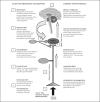Treating chronic pain: new knowledge, more choices
- PMID: 22811639
- PMCID: PMC3396104
- DOI: 10.7812/TPP/05-067
Treating chronic pain: new knowledge, more choices
Figures








References
-
- Glajchen M. Chronic pain: treatment barriers and strategies for clinical practice. J Am Board Fam Pract. 2001 May–Jun;14(3):211–8. - PubMed
-
- Woolf CJ, American College of Physicians; American Physiological Society Pain: moving from symptom control toward mechanism-specific pharmacologic management. Ann Intern Med. 2004 Mar 16;140(6):441–51. - PubMed
-
- Brookoff D. Chronic pain: 1. A new disease? Hosp Pract (Off Ed) 2000 Jul 15;35(7):45–52. 59. - PubMed
-
- International Association for the Study of Pain. IASP Pain Terminology [homepage on the Internet; about 8 screens] [cited 2005 July 19]. Available from: www.iasp-pain.org/terms-p.html.
-
- Coghill RC. Brain mechanisms of pain: Overview Section on: Neural correlates of inter-individual differences in the subjective experience of pain [homepage on the Internet] [cited 2005 Oct4]. Available from: www1.wfubmc.edu/Nba/Faculty/Labs/coghill/Individual+Differences.htm.
LinkOut - more resources
Full Text Sources
Other Literature Sources
Medical

